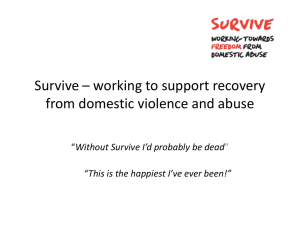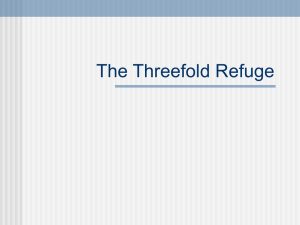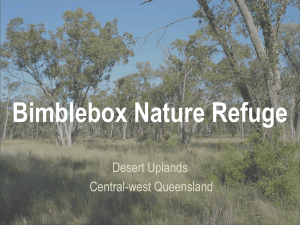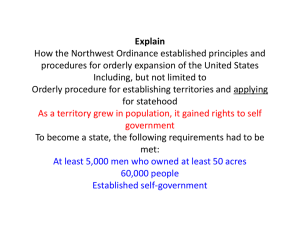Naseem Anwar
advertisement
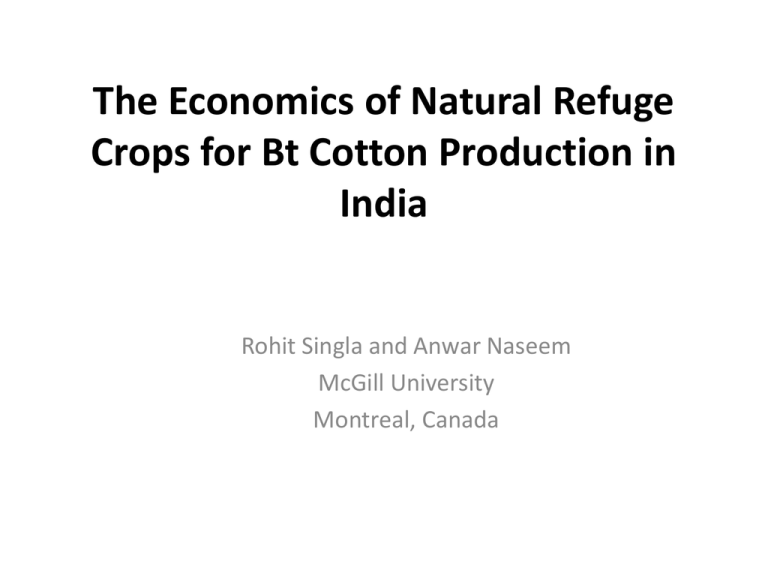
The Economics of Natural Refuge Crops for Bt Cotton Production in India Rohit Singla and Anwar Naseem McGill University Montreal, Canada Pros and Cons of Growing Bt Crops Benefits of growing Bt crops (such as Bt cotton and Bt corn) compared to non-Bt/refuge • Increased crop yields • Reduced production costs • Environment friendly Resistance evolution problem 2 Refuge Requirements for Resistance Management • US EPA: Fixed refuge policy – 5% if the farmer does not spray any conventional pesticide – 20% if the farmer sprays • Other countries (both developed and developing) basically follow the same strategy. For example: Mexico; India; Canada. Refuge Structured vs. Natural Refuge • Structured refuge – Mandatory refuge of the same crop – More common in developed countries where farms are big and cropping pattern is monocropped – E.g. non-Bt cotton grown with Bt cotton • Natural refuge (Unstructured refuge) – Voluntary refuge of other crops hosting the same pest – More common in developing countries where farms are small and fragmented – E.g. sunflower, pigeon pea, chilli, sorghum etc. grown alongside Bt cotton Effectiveness of Natural Refugia • It has now been documented by a number of studies (Huang et al. 2010; Singla, Johnson, and Misra 2013; Ravi et al. 2005; Qiao et al. 2010; Gustafson, Head, and Caprio 2006) that natural refuge can help in delaying pest resistance in Bt crops by supporting target pest populations. Gaps in Knowledge • Previous studies (examining refuge requirements for Bt crops) considered all natural refuges together in the model. • Failed to examine the individual contributions of various natural refuges. Motivation • To better understand the individual contributions of different crops to act as natural refuges • To identify natural refuge crops and resistance management strategies for optimal pest control and profit maximization Context • Bt cotton in India • We consider the implications for seven natural refuge crops: sunflower, pigeon pea, corn, chickpea, chillies, okra, tomato, Modeling Framework Biological Model: •simulates the evolution of resistance in bollworms to Bt cotton/pesticides •accounts for proportion of Bt cotton planted •accounts for proportion of larvae in cotton and other host plants •accounts for proportion of larvae in cotton sprayed with pesticides Profit Model: It is assumed that the representative producer chooses ‘qt’ that will maximize year t’s profit without considering production possibilities in the future, subject to refuge type 0 ≤ qt ≤ rt ≤ 1; yield models; and other parameters Regulatory Model: objective is to choose a refuge requirement (rt) that maximizes discounted profits received during T years, subject to: refuge type 0 ≤ rt ≤1; state transition equation given by biological model; profit model; yield models; discount rate ρ; and other parameters 9 Data and Parameters • Biological – Relative densities of CBW on different crops from Ravi et al (2005) – Five generations of CBW in one year • Assume environmental fitness factor of 0.6650 • Assume pesticide spray affects 3rd and 4th gen • Bt and pyrethroid resistance parameters from Kranthi et al (2005) • Economic – Cotton (lint) price of $1.49/kg; Yield 807.5 kg/ha; Pesticide spray cost from Qaim (2003), Francis Kanoi Approach • What is the individual contribution of the seven natural refuge crops? • What are the cropping patterns under different cropping patterns • How sensitive are the refuge requirements to different biological and economic parameter values Efficient structured refuge size Planning Horizons Pigeon pea Refuge APVb Chickpea Refuge APV Sunflower Refuge APV Okra Refuge APV Tomatoes Refuge APV Chilies Refuge APV Corn Refuge APV 1 0 (0)a 824.99 0 (0) 823.65 100 (100) 803.96 0 (0) 826.19 0 (0) 816.41 0 (0) 811.28 0 (0) 824.03 2 0 (0) 824.96 0 (0) 822.54 100 (100) 803.96 0 (0) 825.83 0 (0) 815.78 0 (0) 810.75 0 (0) 823.99 3 0 (0) 824.96 7 (5) 820.51 100 (100) 803.96 0 (0) 825.55 2 (0) 814.50 7 (0) 810.17 0 (0) 823.93 4 0 (0) 824.78 15 (12) 818.77 100 (100) 803.96 0 (0) 824.88 13 (0) 813.48 13 (0) 809.38 0 (0) 823.71 5 0 (0) 824.67 22 (20) 817.53 100 (100) 803.96 3 (0) 823.65 20 (4) 23 (3) 808.78 0 (0) 823.37 6 0 (0) 824.58 26 (24) 816.51 100 (100) 803.96 10 (0) 822.46 27 (10) 811.86 30 (12) 808.42 0 (0) 822.80 7 0 (0) 824.49 33 (30) 815.76 100 (100) 803.96 12 (6) 821.50 34 (15) 811.34 32 (18) 808.07 2 (1) 821.93 8 0 (0) 824.34 35 (34) 815.12 100 (100) 803.96 19 (10) 820.61 35 (21) 810.92 38 (23) 807.82 6 (4) 820.94 9 0 (0) 824.19 40 (37) 814.56 100 (100) 803.96 21 (14) 819.88 41 (26) 810.54 40 (26) 807.62 11 (10) 820.11 10 0 (0) 823.94 41 (41) 814.10 100 (100) 803.96 26 (16) 819.28 41 (29) 44 (32) 807.43 17 (13) 819.35 812.53 810.25 a. Figures in parentheses are efficient refuge requirements when pyrethroid resistance is not considered in the base model. b. APV values are reported in the US dollars/hectare. Efficient refuge under different pest density/acreage under a natural refuge Cotton: Natural Pest density Min refuges relative proportion Pest Density 1: ½ 24 (1)a 1:1 11 (0) 1:1½ 11 (0) 1:2 0 (0) Pest density Average Pest density Max 48 (23) 26 (3) 15 (0) 10 (0) 85 (72) 47 (29) 36 (14) 27 (4) Note: The model was run for cotton-okra planted on adjacent plots of equal size. a. Figures in parentheses are efficient refuge requirements for 5 years Efficient refuge under various cropping patterns Natural refuge crops Cropping patterns 1 Cotton Pigeon pea Sunflower 2 Cotton Pigeon pea Chili 3 Cotton Pigeon pea Chickpea 4 Cotton Pigeon pea Chickpea 5 Cotton Okra Tomato 6 Cotton Chili Corn 7 Cotton Okra Corn 8 Cotton Sunflower Corn Sunflower Tomato Refuge requirements 65 (49)a 20 (0) 18 (0) 43 (18) 33 (11) 28 (2) 11 (0) 47 (27) Note: It was assumed that cotton and natural refuge crops are grown on adjacent plots of equal size. a. Figures in parentheses are efficient refuge requirements for 5 years starting from 2011-12 cropping season Sensitivity Analysis: 5-year planning horizon PARAMETERS/VALUES Value Biological Parameters RR Bt Fitness 0.85 RS Bt Fitness 0.46* SS Bt Fitness 0.02 RR Bt Fitness Untreated/ 0* Fitness costs RR Pyrethroid Fitness 0.29 RS Pyrethroid Fitness 0.0418* SS Pyrethroid Fitness 0.0002* RR Pyrethroid no selection 0.66 pressure Environmental Fitness 0.27 Economic Parameters Insecticide use equation α = 22.39 parameters β = -113.61 Yield loss function parameters δ = -3.11 γ=0 Pyrethroid application cost 5.0 Fixed Production costs Bt 270.44 Fixed Production costs non-Bt 260.68 Output price 0.92 Interest rate 4 Refuge Value (%) Refuge Value (%) Refuge Value (%) Refuge (%) 0 0 51 16 0.90 0.60 0.06 0.05 0 23 42 12 0.95 0.70 0.25* 0.1 0 46 0 6 1* 0.80 0.35 0.15 0 70 0 4 0 0 0 0 0.4845* 0.1324 0.042 0.77 0 0 0 0 0.66 0.24 0.07 0.89 0 0 0 0 0.85 0.4 0.1 1* 0 0 0 0 0 0.4732 0 0.665* 0 0.8 0 0 α = 35.03* β = -63.06 δ = -2.39* γ = 0.14* 9.27* 323.0* 301.06* 1.49* 7.75* 0 α = 39.24 β = -46.22 δ = -2.15 γ = 0.21 12.02 390.28 320.08 1.75 8.2 0 α = 47.67 β = -12.52 δ = -1.67 γ = 0.31 15.06 420.42 380.28 2 9 0 0 0 0 0 1 0 0 0 0 0 0 0 0 0 0 0 0 0 0 0 100 0 0 0 Conclusions • Pigeon pea, corn and okra are found as the most cost effective natural refuges. • Sunflower is found as the least cost effective natural refuge. • Efficient refuge size varied significantly under various cropping patterns Implications • The framework developed by this study can be used to assess the structured refuge requirements in a specific crop-mix. • The assessment can help in making suggestions to farmers on type of and acreage under a natural refuge crop they may plant. • The framework developed by this study will help in evaluating the role of natural refuges for Bt crops in other countries. Thanks!
